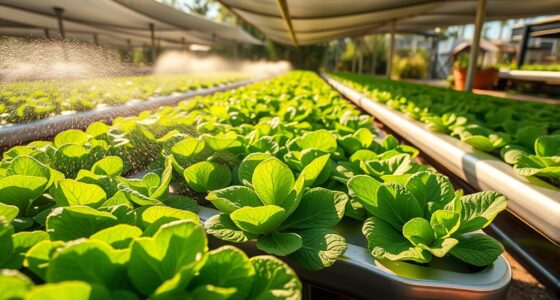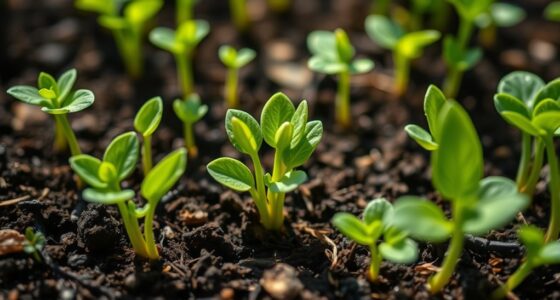To prevent blossom end rot in hydroponics, guarantee your plants get enough calcium by using nutrient solutions rich in calcium nitrate or calcium chloride. Keep your pH stable between 5.5 and 6.5, as pH imbalance can hinder calcium absorption. Maintain consistent watering and avoid fluctuations, which can block calcium movement. Monitoring and adjusting your nutrient mix regularly is key. If you want to learn specific strategies to keep calcium levels ideal and disease-free, you’ll find helpful tips ahead.
Key Takeaways
- Regularly monitor and maintain calcium levels in the nutrient solution using calcium nitrate or chloride.
- Keep pH between 5.5 and 6.5 to ensure calcium remains soluble and accessible.
- Ensure consistent watering to facilitate uniform calcium transport within plants.
- Prevent nutrient antagonism by balancing potassium and magnesium to avoid calcium uptake interference.
- Observe plants routinely for early signs of deficiency and adjust nutrient formulations promptly.

Calcium plays a pivotal role in hydroponic systems by supporting plant cell structure and facilitating nutrient uptake. Without enough calcium, your plants can become weak, more susceptible to diseases, and less productive. In hydroponics, where soil isn’t present to naturally supply nutrients, maintaining proper calcium levels becomes essential for healthy growth and high yields. When calcium is deficient, one of the most noticeable problems is blossom end rot, a disorder that causes dark, sunken spots on the fruit’s bottom. By understanding how calcium functions and how to keep its levels ideal, you can prevent this issue before it even begins.
In hydroponic setups, calcium is typically supplied through nutrient solutions. However, calcium’s availability can be compromised by factors like pH imbalance, high levels of other nutrients, or improper solution formulation. If the pH of your solution drifts outside the ideal range—usually around 5.5 to 6.5—calcium absorption drops considerably. This means even if you’re adding calcium-rich nutrients, your plants might not get enough. Regularly monitor and adjust pH levels to verify calcium remains soluble and accessible. Also, be mindful of nutrient antagonism, where excess amounts of certain nutrients, like potassium or magnesium, can interfere with calcium uptake. Striking the right balance in your nutrient mix is key.
To prevent blossom end rot, verify your plants receive consistent and adequate calcium. You can do this by using a well-formulated nutrient solution that emphasizes calcium content or by supplementing with calcium nitrate or calcium chloride if necessary. These forms of calcium are water-soluble and readily absorbed by your plants. It’s also helpful to maintain stable environmental conditions—avoid sudden temperature swings or inconsistent watering, both of which can cause fluctuations in calcium uptake. Consistent watering practices promote steady nutrient absorption and prevent stress that might hinder calcium transport within the plant.
Another practical step is to regularly inspect your plants for early signs of calcium deficiency, such as distorted or curled new leaves, which can indicate trouble before blossom end rot manifests. Address deficiencies promptly by adjusting your nutrient solution or environmental conditions. Remember, calcium moves through the plant with the transpiration stream, so maintaining proper moisture levels is essential. Too little water reduces calcium movement, increasing the risk of localized deficiencies like blossom end rot.
Frequently Asked Questions
Can Calcium Deficiency Cause Other Plant Diseases Besides Blossom End Rot?
Yes, calcium deficiency can lead to other plant issues besides blossom end rot. It weakens cell walls, making plants more vulnerable to diseases like damping-off, root rot, and leaf spots. Without enough calcium, your plants struggle to develop strong structures and resist pathogens. To prevent this, guarantee consistent calcium levels in your hydroponic system, monitor nutrient solutions, and maintain proper pH to optimize calcium uptake and keep your plants healthy.
How Does Ph Impact Calcium Uptake in Hydroponic Systems?
pH critically impacts calcium uptake in hydroponic systems. When the pH is too high or too low, your plants can’t efficiently absorb calcium, leading to deficiencies like blossom end rot. Aim for a pH level around 5.8 to 6.2, which optimizes calcium availability. Regularly monitor and adjust your nutrient solution’s pH to guarantee your plants get the calcium they need for healthy growth.
Are Certain Hydroponic Systems Better at Delivering Calcium?
Of course, some hydroponic systems are better at delivering calcium—shocking, isn’t it? Drip systems with precise nutrient control often excel at maintaining consistent calcium levels, preventing issues like blossom end rot. Deep water culture setups also work well if managed properly. So, if you want happy plants and fewer problems, choose a system that offers tight nutrient regulation and good circulation. Your tomatoes will thank you.
What Are Natural Sources of Calcium Suitable for Hydroponics?
You can use natural calcium sources like crushed eggshells, oyster shell calcium, or coral calcium in your hydroponic system. These options release calcium slowly, helping prevent blossom end rot. Add them to your nutrient solution or as a top dressing, ensuring they dissolve properly. Regular application maintains calcium levels, promoting healthy fruit development and avoiding deficiencies. Just make sure to monitor pH, so calcium remains available to your plants.
How Quickly Can Calcium Supplementation Prevent Blossom End Rot?
You might be surprised, but calcium supplementation can often prevent blossom end rot within just a few days if you act fast. When you promptly add calcium to your hydroponic system, it quickly improves cell wall strength, stopping the rot before it begins. Don’t wait for symptoms; timely intervention works wonders, and you’ll see healthier fruits and fewer wasted plants in a matter of days.
Conclusion
Think of calcium as the sturdy backbone of your plants’ health, holding everything together. If you neglect it, your plants become fragile, prone to problems like blossom end rot. By ensuring your hydroponic system supplies enough calcium, you’re building a solid foundation that keeps your plants thriving. Don’t let this essential nutrient slip through the cracks—nurture it, and watch your garden flourish like a well-oiled machine, resilient and bursting with life.










